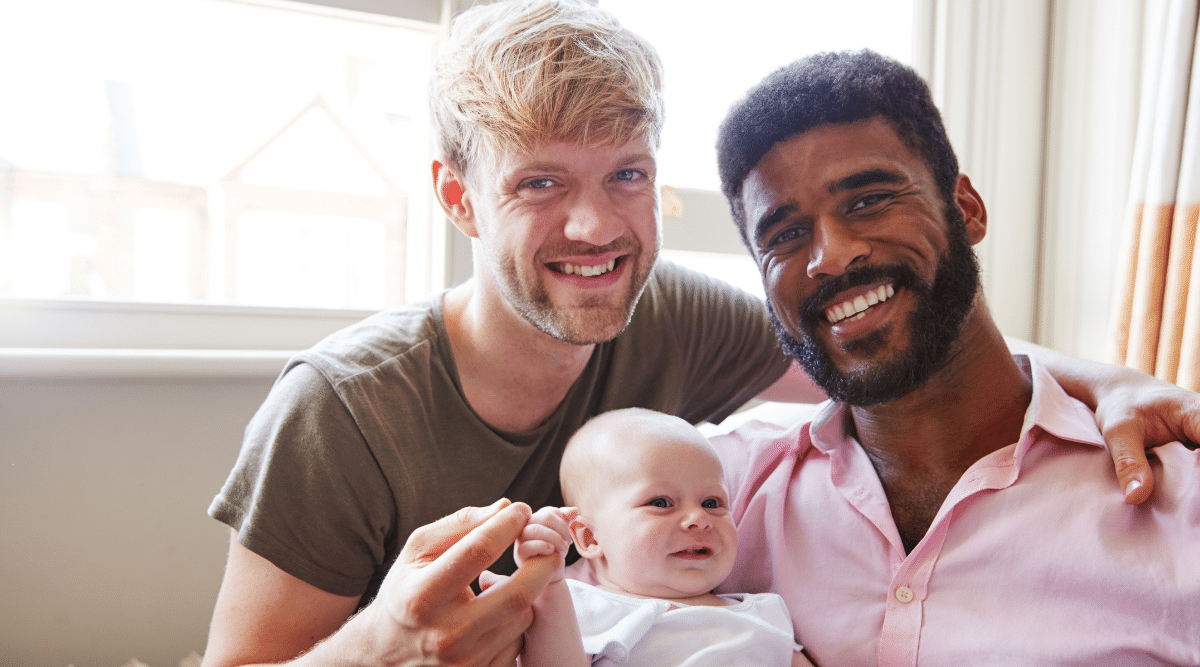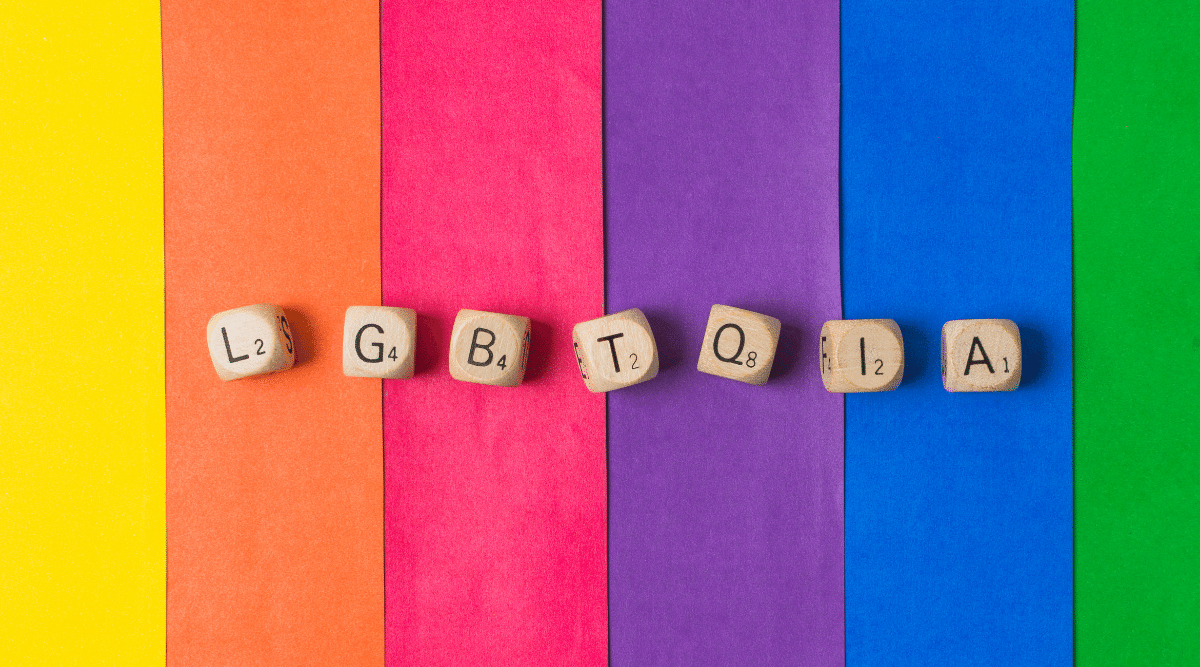LGBTQIA+ Terms Explained
There are many terms out there being used to describe individuals’ gender identity and sexuality. Some, you may feel clear about, while others might leave you at a loss. This guide aims to explain several key terms briefly and straightforwardly. Use the quick links below if you would like to jump to a specific section:
- LGBTQIA+ – The acronym explained
- The difference between sex, gender and sexuality?
- What is a rainbow family?
- What are personal pronouns, and why do they matter?
LGBTQIA+ – The acronym explained
You might already know that LGBTQIA+ stands for Lesbian, Gay, Bisexual, Transgender, Queer, Intersex, Asexual… Plus. However, what do all these terms mean?
- L is for Lesbian – A lesbian is a woman who feels sexually or romantically attracted to other women rather than men. There are many stereotypes associated with lesbians, from the overly masculine to the highly feminine woman. The truth is that lesbians are as individual as straight women; there is no one way for a lesbian to be or look.
- G is for gay – The term gay refers to a gay man, that is, a man who feels sexually or romantically attracted to other men rather than women. Like lesbians, there are many stereotypes associated with gay men, and again, there is no one way for a gay man to be or look.
- B is for bisexual – A bisexual individual feels attracted sexually or romantically to more than one gender. Some bisexual individuals may feel equally attracted to both men and women. Others may feel a stronger attraction to one gender over the other. A common myth is that bisexual individuals are ‘confused’. This opinion demonstrates a lack of respect for and understanding of bisexual individuals and the complexity of sexuality.
- T is for transgender – Being transgender means identifying with a gender other than the one you were assigned at birth. Many transgender individuals take hormones to help bring their body characteristics in line with their gender identity. For example, this could include growing facial hair or developing breasts. Some transgender individuals also have gender confirmation surgery to permanently change their body parts to conform with that gender.
- Q is for Queer or Questioning – The Q is considered to have two meanings. The first is queer, which is generally considered an umbrella term for anyone who is not heterosexual. However, the term queer has also been adopted by some individuals as gender identity, while others believe it is a slur, which makes queer a tricky term to define. The Q is also considered to stand for questioning, referring to an individual still questioning their sexuality or gender identity.
- I is for Intersex – Intersex describes an individual born with anatomy that doesn’t neatly conform to our understanding of ‘male’ and ‘female’. People who are intersex may have characteristics that are a mixture of male and female, including chromosomes, gonads (testes or ovaries), sex hormones and genitals. The term hermaphrodite was often used in the past, but this term is considered inaccurate and outdated. Sometimes surgery is recommended to bring the anatomy of intersex babies and children in line with male/female norms. However, as we increasingly understand gender identity, it is preferred that surgery be postponed until a child is old enough to identify their own gender identity.
- A is for Asexual – An asexual individual lacks a sexual attraction to others of any gender. Some consider asexuality to a sexual orientation, while others consider it an absence of sexual orientation. Asexual individuals may still experience romantic attraction to others of one or more genders. They may identify as transgender, gay, lesbian, bisexual or straight, depending to whom they feel an attraction.
- Plus stands for everything else – Over 60 terms describe gender identity or expression. The plus in LGBTQIA+ aims to acknowledge that the seven terms directly represented do not encompass all individuals’ gender identities or sexual orientations.
LGBTQIA+ Terms Explained: The difference between sex, gender and sexuality?
- Your sex refers to the gender you were assigned at birth based on your biology, including chromosomes, gonads (testes or ovaries), sex hormones and genitals. As we discovered when exploring the term intersex above, your sex is not always easily defined as male or female.
- Your gender refers to your sense of who you are – a man, woman or something else? This sense of identity might match your biology and anatomy, referred to as cisgender. Where gender identity is a mismatch for your sex, we may refer to this as transgender. However, there is more to this than feeling ‘male’ or ‘female’. Some individuals identify with aspects of both these genders, others with neither, referred to as non-binary or gender diverse. Gender identity can change or evolve throughout their life.
- Your sexuality defines who you are attracted to romantically, sexually or both. Like gender identity, sexuality can evolve and change over time, which does not mean the person is ‘confused’. Instead, our understanding of our sexuality and gender can mature as we age, in the same way that our understanding of our emotions, for instance, grows and changes over time.

LGBTQIA+ Terms Explained: What is a rainbow family?
The term rainbow family is a blanket term used to describe a family where the parents do not conform to traditional male/female or mother/father norms. In rainbow families, at least one parent identifies as lesbian, gay, bisexual, pansexual (being attracted to people regardless of gender), transgender, gender diverse, intersex, non-binary, queer or asexual.
An extensive body of research spanning more than 30 years demonstrates that children in rainbow families grow and develop as well as their ‘non-rainbow’ peers. The only documented negative effect of being in a rainbow family is the discrimination parents and children can experience from others and the effect this has on their mental health. This discrimination is something communities can change by supporting and respecting rainbow families!
LGBTQIA+ Terms Explained: What are personal pronouns, and why do they matter?
A personal pronoun is a short word we use in a sentence in place of a person’s name. Most personal pronouns have no implied gender e.g., ‘I’, ‘you’, ‘they’, “me”, ‘we’, “us”, ‘them. The only personal pronouns in the English language that automatically imply a gender are ‘him’, ‘her’, ‘he’ and ‘she’.
The personal pronouns we choose reflect our gender identity. When they are misused, personal pronouns can insult that identity. For example, if you identify as male and are referred to as ‘her’ or ‘she’, this can be annoying at best and downright hurtful or insulting at worst. Some individuals may be happy to be referred to as either ‘he’ or ‘she’ interchangeably. Others prefer gender-neutral pronouns such as “they” and “them”.
The personal pronouns an individual chooses for themself are entirely their decision. There are no rights or wrongs, and it is not up for debate. What matters most is that others recognise an individual’s preferred personal pronouns. To do so is to acknowledge that you value and respect their gender identity.
But, how do you know what pronouns to use? The simplest way is to ask. There is absolutely nothing wrong with a polite question, for example, ‘Hi there. My name is Arizona. My preferred personal pronouns are he and him. Can I ask what personal pronouns you prefer, Jade?’ If you slip up and use an incorrect personal pronoun, don’t panic. Apologise! No one expects you to be perfect, but they expect you to be respectful.
What to read more?
The following articles explore aspects of, and issues within, the LGBTQIA+ community and may be of interest to you:
- Same-Sex Families – Are the children REALLY okay?
- Rainbow Families – Strategies for seeking support during pregnancy, labour and early parenthood
Reference List
PBB aims to keep you informed with the latest research-based information. Check out our reference list used in the creation of this article.
Published 12th April 2022
About the Author
Yvette Barton has a Bachelor of Education and currently works as both an eLearning Adviser for Swinburne Online Learning, and as a freelance writer and editor. She is a fierce advocate for homebirth, women’s rights to choose where they labour and birth, and trained midwives’ rights to attend birthing women without governmental constraints. Yvette is also an advocate for natural and adoptive breastfeeding, co-sleeping, babywearing, conscious parenting, and child advocacy. She lives in Sydney with her two daughters.
Share this Post
Recent Posts
Recent Comments
- Rachana on Lotus Birth by Lavendilly
- Rachana on Ask the physio: Jolly jumpers, carriers and other ‘dos and don’ts’ for baby’s development
- Jane Palmer on Wagga Wagga Base Hospital
- Kiera Fenn-Lavington on Wagga Wagga Base Hospital
- Jane Palmer on How to use your breast milk donation to help other mums and unwell bubs
Archives
Categories
PBB’s Social Media Pages
The post LGBTQIA+ Terms Explained appeared first on Pregnancy Birth and Beyond.




